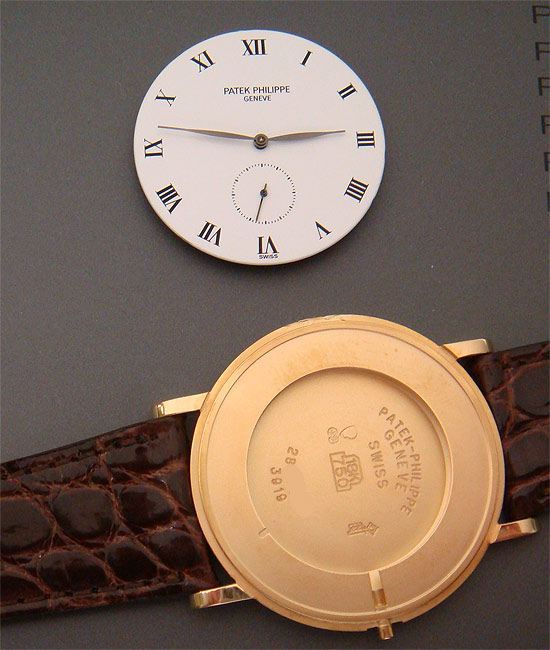
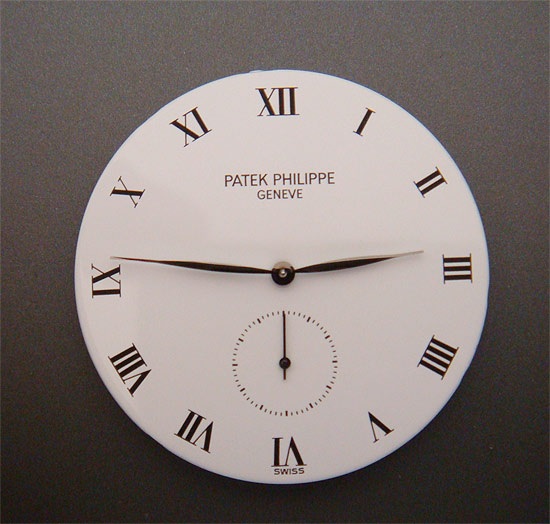
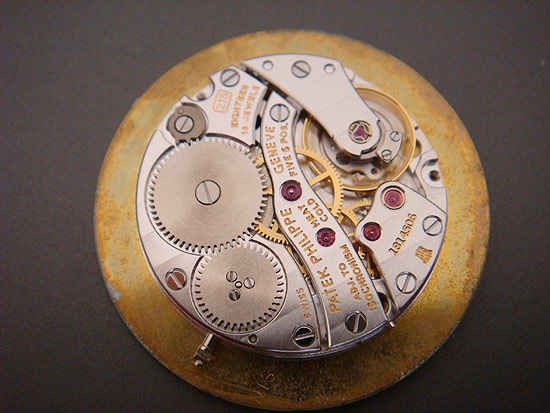
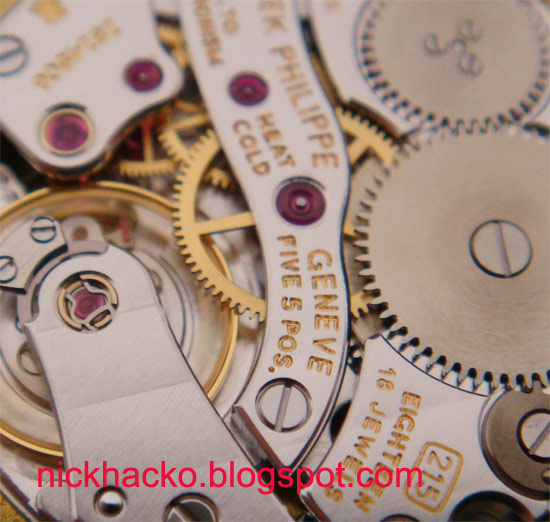
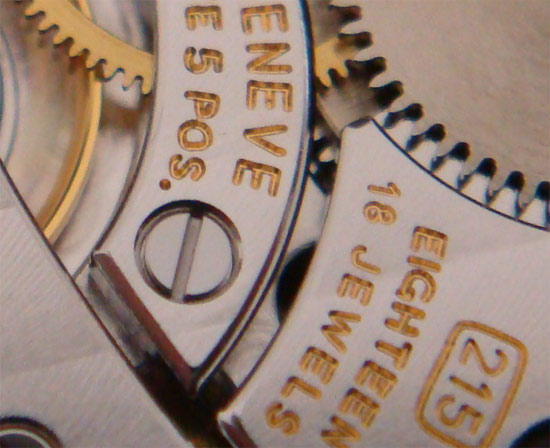





While I was doing the overhaul, Tanya had fun with watercolours.

Ref 2515 is a very typical example of a mid to late 1950s Patek watches. It is fitted with iconic movement Cal. 12-400 which was in use from 1950 to 1962. Patek produced a total of 10,000 Cal 12-400 movements which means that less than 1000 pieces were manufactured each year. Some reference numbers like 2515 with short lugs are now rarely seen on the market.
Each bridge is stamped with the last 3 digits of the movement number which takes us back to the days of hand finished movements. This touch of individuality is not something you will find in a new Patek!
In addition, the bezel is also stamped with the 3 last digits of the case number.
The complete overhaul was really a straight forward job. In its 54 years, this is only the third time it has been overhauled. Nevertheless, the pivots and jewels are still finely polished due to the fact the watch was used only on special occasions.
The original ivory colour dial is nicely aged and gives the watch a warmth and unmistakably vintage look.
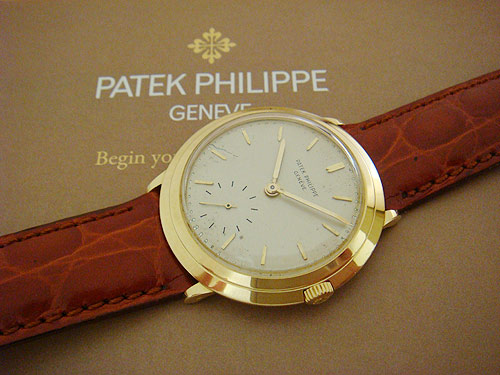
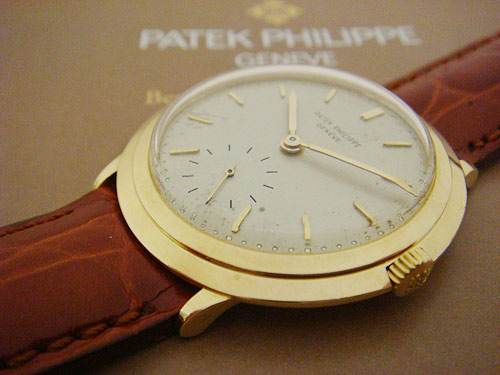
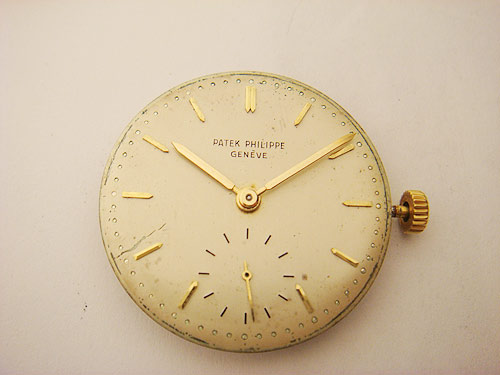
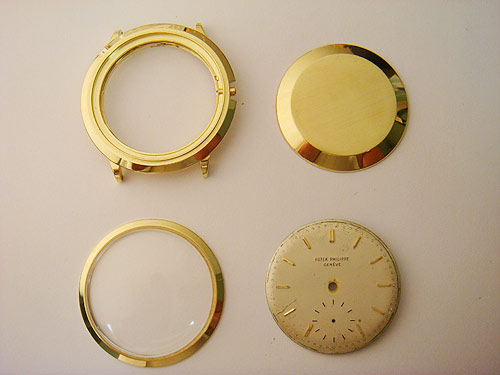
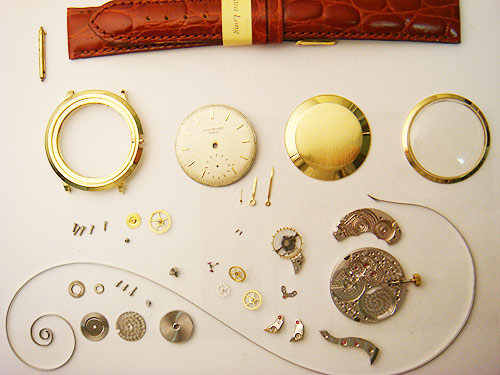
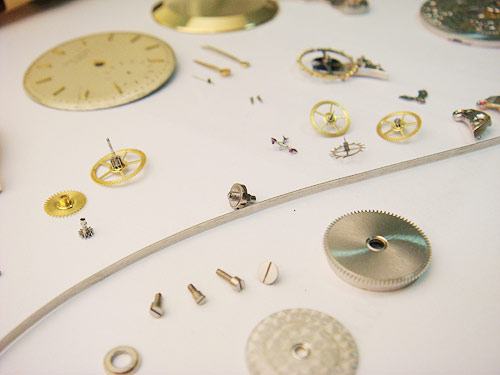
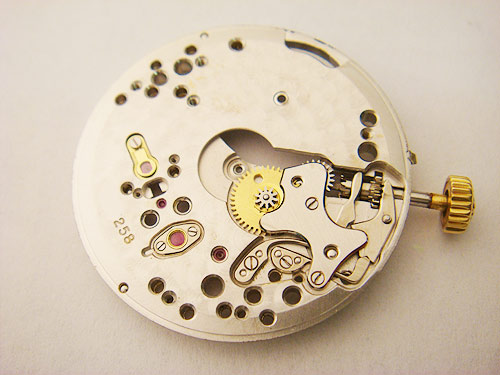
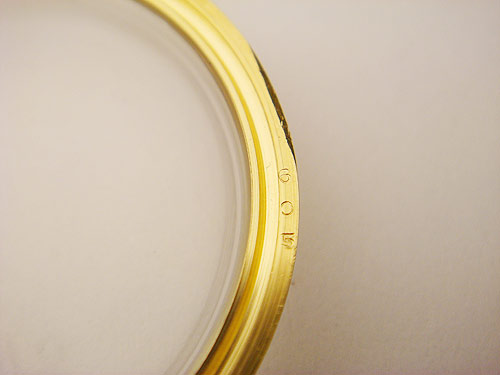
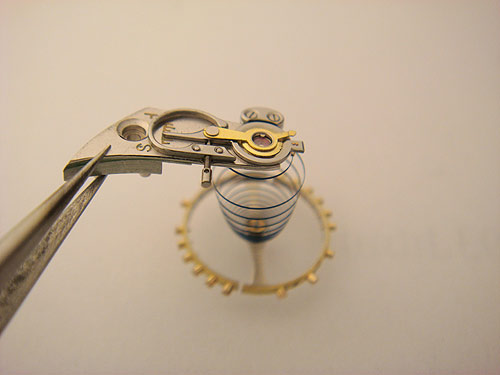
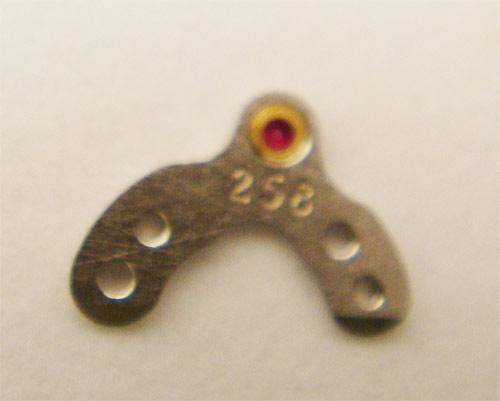
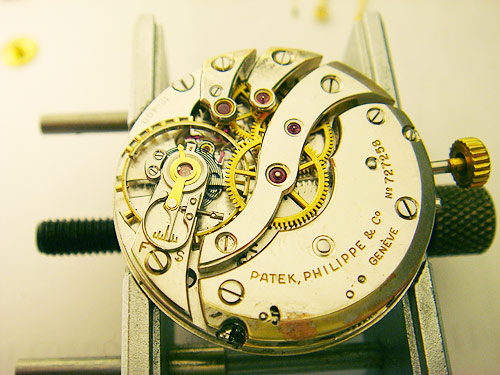
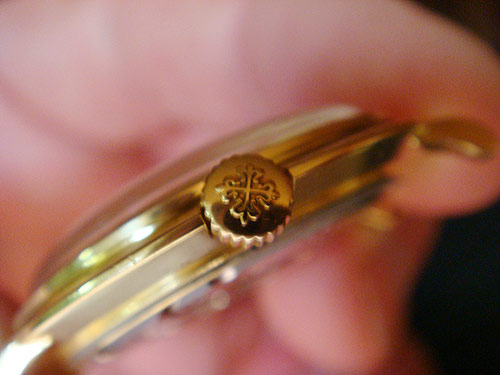
At their peak production (early 1900s) pocket watches were available in all imaginable styles and decorations, with all sorts of complications. The price range started from a famous $1 Ingersoll to more common nickel-cased daily wearers, precision railroad timekeepers to fancy gold cased gem studded "Royalty" examples. And on the very top were complicated perpetual calendars, chronographs and repeaters.
And then, there were the really cool and sophisticated, artistic niello pocket watches.
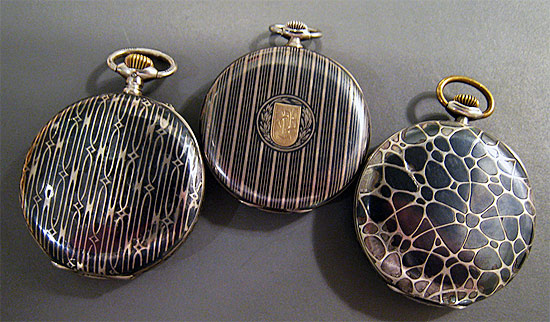
Niello is a black alloy (lead, copper, silver, sulphur and sal ammoniac) which was filled into a chiseled or engraved silver case. The niello paste was then fired. The excess alloy - which was very hard - was then removed with a file, and the remaining surface was then polished.
Being a silver based alloy, it 'fused' perfectly with the silver case, leaving a striking black and white appearance.
Needless to say, engraving a silver case for a niello required both craftsmanship and artistry. Some of the most distinctive, intricate and beautiful Art Nouveau niello cases were produced in early 1900s and I have no doubt that Draper Senior would have a such a piece in his waist coat.
So next time you see a niello pocket watch, don't rush- take your time to study the smooth patterns and immerse yourself in the fascinating world of fine horology.
If you wish to start your pocket watch collection then here are the 3 most important thing to look for:
- go for an example with perfectly preserved niello, but also one with an intriguing pattern
- go for a brand name (Omega for example, or Longines)
- the watch mechanism must be in good working order, the winding system flawless and the balance wheel unaltered, preferably with original balance staff. And the porcelain dial intact, free of any hairlines.
Based purely on the pattern, my pick would be wither one on the left or on the right (on above photo) where the middle example would be less desirable because of the crest.
Happy collecting!
And who would think that so many of us would watch a plotless American TV show with such passion! Like it or not, there is something nostalgic about the 1950s/60s where men were mad and ladies so painfully fashionable.
The series is an absolute feast for the eyes. The colours, decor, costumes, fashion and over and above all: the charming elegance.
You may not believe this, but today, on my way to work, I saw a man wearing a grey Don Draper suit, spotless white shirt, shiny Oxford shoes and - wait for it - a hat!
Now, you may say: well, this look is never going to work in Sydney. And you are quite right, because Don Draper does not text or sms or play silly games on his ipad on public transport like you do. DD is not a sterile, politically correct misogynist-metrosexual. Don was simply a product of a context, a part of it's fabric - not an imitation.
And this is the reason why the look cannot work: we cannot bring the context of the 60s into 2013.
But there is, however, one detail which does not need a context to turn you into a cool and elegant man. An item so contextless which like a black hole bends the time around itself: a vintage watch!


If it was good for Aleksey Arkhipovich Leonev, it's good for you too!
Russian cosmonaut Aleksey Arkhipovich Leonov, Soviet Air Force Major General with his Flightmaster. Worn on Soyuz 19 mission in 1975.
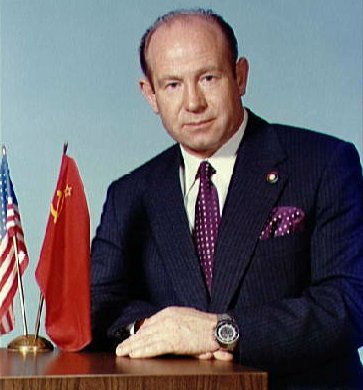
Designed for pilots. Worn in space: Omega Flightmaster Cal 911 ST145.036. Case 43 x 52mm. Complete set with box and papers. Original 1970s model.
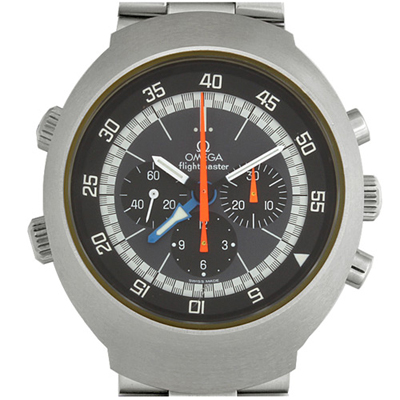
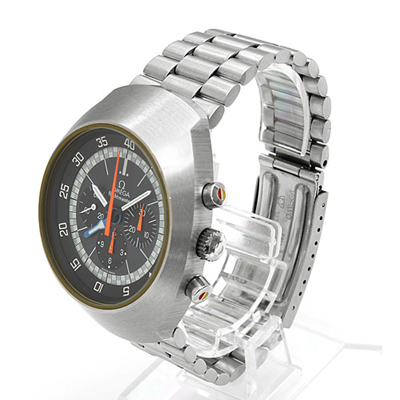
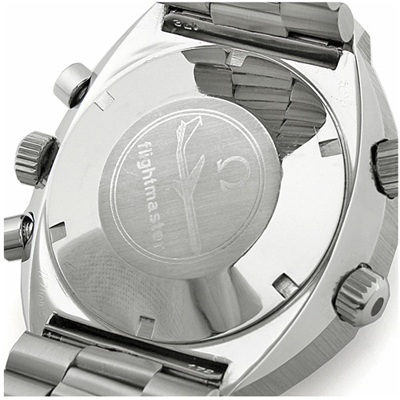
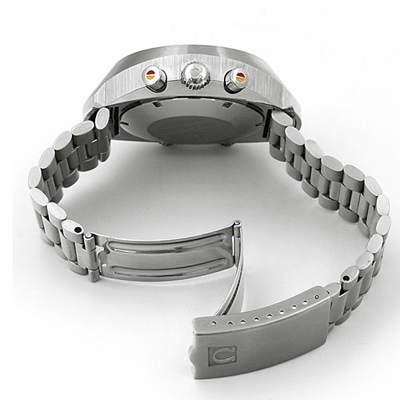
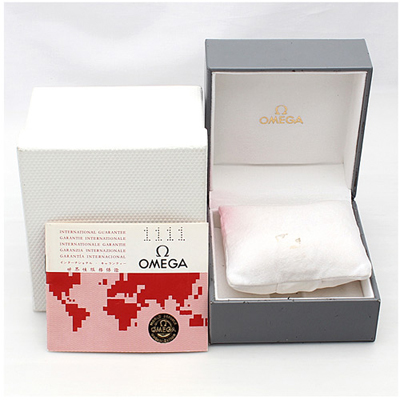
Watches with original and unaltered dials are worth significantly more than those with repainted or refurbished dials. Actually, in most cases it is always better to leave the old dial in "as is" condition than to undertake any restoration at all.
Today, I acquired a lovely 1957 Omega Constellation, for my personal collection. It is an all original example in a handsome 18K gold case.
However the dial itself was a shocker! It was covered with some kind of fluff which over time had 'glued' itself to the dials lacquer. The watch spent 25 years in a deposit box and has now reached a stage where any attempt to remove the fluff would cause further damage.

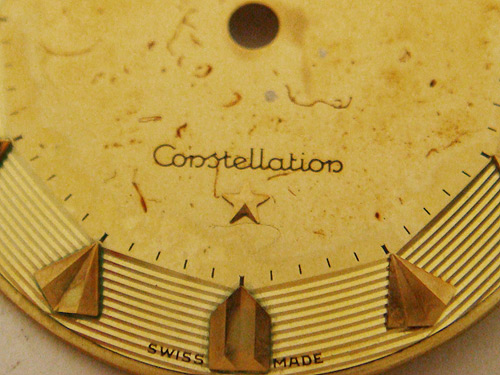
Obviously finding a new dial would be impossible and sending it to Switzerland for restoration would be a lengthy and expensive undertaking with a dubious result.
After some closer examination, I decided to take the risk and clean the dial. I felt that with a bit of luck, some mild cleaning liquid would dilute the gunk to the point where the fluff could be removed without removing the lacquer and lettering. A risky and nerve-racking operation indeed!
The end result was way beyond my expectation. With the help of a fine-hair paint brush, the dial cleaned nicely. The fluff was softened, then removed and finally the Constellation dial revealed itself in its full glory. Not a single letter or bit of lacquer was removed / lost in the process!
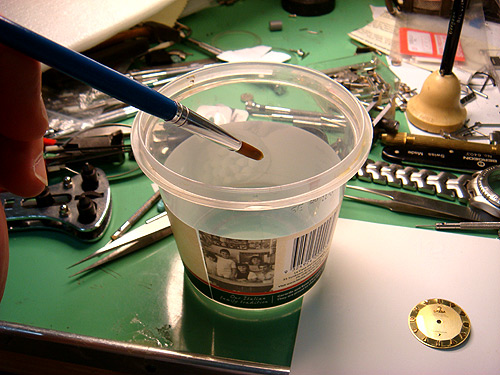
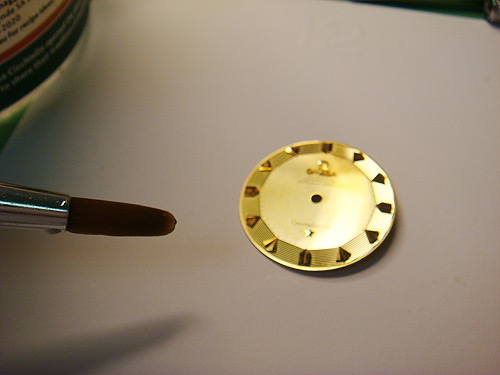

So, what was the mysterious cleaning liquid you wonder? Send me an email and I would be more than happy to share the secret with you.
Of course, the full credit for this 'restoration’ goes to maker of this magnificent 1957 Omega pie-pan dial. What a beauty!
You've been a smart kid and you've studied hard. Your law (or medical) degree is testimony to your commitment to science and humanity and the long client list is indisputable proof that you are good in your field of expertise.
But deep down in your heart you know you could have done much better devoting your life to politics, watchmaking, or even the noble and fine art of second hand dealing. The question is: do you have what it takes to call yourself a watchmaker? Are you just a dreamer or a rough but flawless diamond with an impeccable eye for detail?
Before you get too excited about changing career, it is my responsibility to assess whether you have what it takes. In other words, are you really "watchmaker material"?
Here we go.
This is a real life example. No tricks, just straight forward thinking.
The photo below shows a ladies' Tudor watch. The watch was sold 2 years ago and back then it was in brand new, unworn condition. Returned to us this week with a note stating "it stopped". The case back was removed as well as the auto winding system, for clarity.
1. Can you see what is *obviously* wrong with this watch?
2. What caused the mechanism to stop?
3. What needs to be done to return the watch to good working order?
4. How long would it take to rectify the problem?
5. How much should we charge the customer?
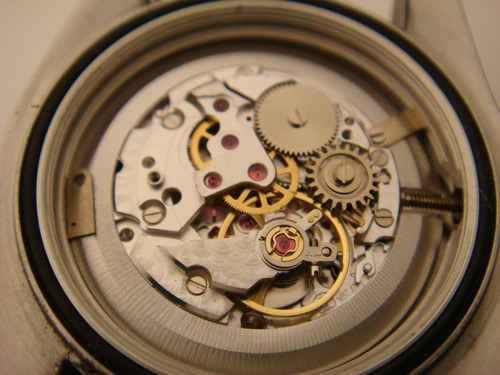
I'll give you just one tip: the watch does not need an overhaul/service, just one very specific repair.
Please don't give up too easily. The answer is below, but if you jump to the answer without giving it a try, you'll kick your bottom and you will say, wow this was too obvious.
You won't find the answer as the fifth most important question online because this is something you should work out on your own and tell me .
--------------------------------------------------------
The problem described above is one of the most common reasons for malfunction found in a wrist watch. Yet it has severe consequences to performance: complete 'denial of service'.
1. Shown on the right (circled in green) is the movement case clamp. It is held in place with a screw. The purpose of the clamp is to hold the mechanism firmly inside the watch case.
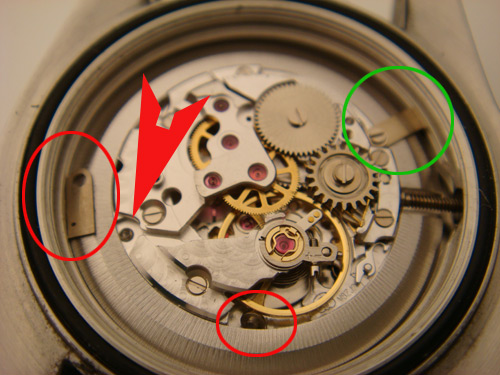
The clamp on the left side (red) got itself detached because the watch head snapped off. 2. The screw head then lodged itself underneath the balance wheel and caused the watch to stop. The good thing: it was clearly exposed for easy removal. If it went further (deeper) into the gear train, the mechanism would need complete disassembly.
However, before the new screw could be installed, the below part of the body need to be extracted.
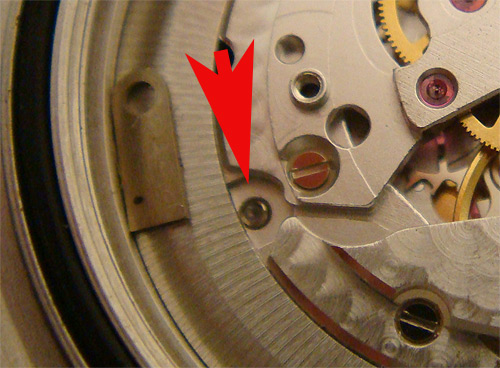
In this particular case, extraction was straight forward because the thread was not damaged.
The reason why the screw head snapped: under higher magnification, the screw body appeared to be flawed, and some impurity in the metal structure is clearly visible.
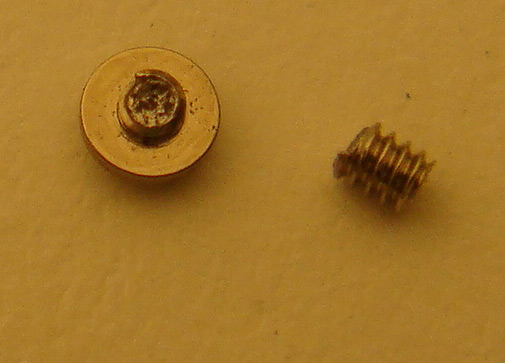
The screw hole after extraction:
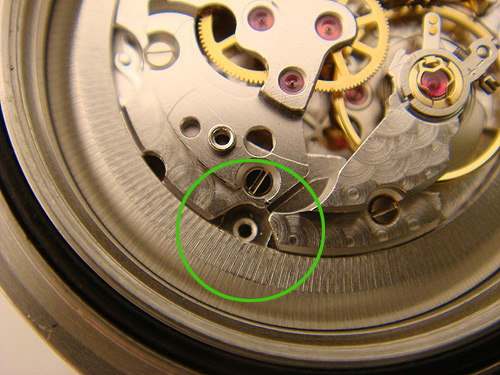
3. clamp re-installed, new screw.
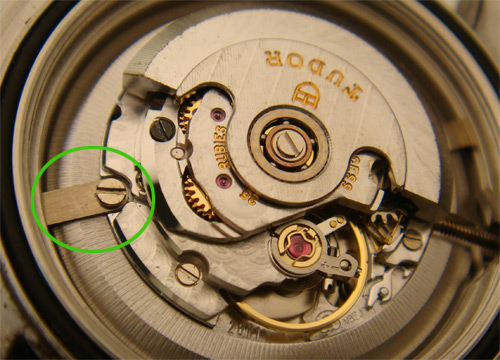
The watch was checked for time keeping (and a minor adjustment was required). The balance wheel was not affected and the auto-winding system with the rotor was reinstalled.
4. Thanks to an easy extraction, the entire repair took approx. 15 minutes.
The broken casing clam screw is often the result of excessive external force (for example, the watch being dropped) Over tightening or an in-built flaw could also be a contributing factor.
5. How much to charge? To determine the cost of the repair, one should take into account many factors: difficulty and complexity of the repair, availability of spare parts and total 'bench' time, including overall turn-around time for the watch to be returned to the customer. Another determining factor is what a watch manufacturer (Rolex) would charge for a similar repair.
What do you think would be a fair and correct amount to charge?
As we always say, happy collecting!
Edward John DENT (1790-1853) manufacturer of Marine Chronometer and astronomical clocks was one of the most famous Watchmakers in England. in 1828. his ship chronometer No. 114 won first prize in the Premium Trials with a variation of 1/2 second in 12 months, and the Admiralty awarded him a prize of 300 pound. His chronometers were used on many explorations in Polar regions and tropics. No. 1800 was owned by David Livingstone (1836) during his African exploration. In 1842 Dent was granted the Royal Errant as "Chronometer Maker to the Queen and HRH Prince Albert".
He was the maker of great clock of House of Parliament, known as Big Ben.



Archive record from The Old Royal observatory, National Maritime museum, Greenwich.
No. 1508 is one of only the handful survived ships chronometer actually made by Dent. The 2A and 259 have been lost. and other 3 older were "exchanged" which most likely means returned to Dent's workshop.



Today, we got a very unique watch - and before you get excited about its stunning look, let’s just pause for a moment and turn our attention to its mechanism: the famous Lemania Cal. 1873. 
Of course, the keen students of horology and "Moon watch" aficionados would no doubt recognize similarities between the Lemania 1873 and the Omega 861 / 1861.
Essentially, the Omega moon watch chronograph is Lemania movement.
The story of Lemania goes back to the year 1884 when Alfred Lugrin setup his workshop in Le Sentier, Switzerland, in the Vallée de Joux and not far from Lake Léman. The story goes that he was taught his watchmaking knowledge by the son of a farmer. Lugrin earned medals for the quality of his work in 1906 at the Milan fair and in 1914 in Bern. He specialized in complicated movements like chronographs and repeaters.
In 1930 his firm became “Lemania Watch Co.”
In 1932 Lemania became part of SSIH (Société Suisse pour l’industrie horlogère), merging with Omega and Tissot. Lemania's chronograph specialty enabled Omega to become the official timer of the Summer Olympic Games in Los Angeles, 1932. And the SSIH quickly grew to over 50 companies.
Later, in 1981, Lemania separated from the SSIH group and was renamed “Nouvelle Lemania”.
In 1983, SSIH merged with USUAG (Allgemeine Schweizerische Uhrenindustrie AG, which included Longines, Rado and other parts manufacturers). The newly formed group was named SMH (Société de Microélectronique et d'Horlogerie) in 1986. Two years later, SHM was renamed to “Swatch Group”, in recognition of the efforts of the small Swatch to save the Swiss watch industry.
In 1992 Nouvelle Lemania went to Investcorp and the Breguet group (“Groupe Horloger Breguet”, a.k.a. GHB). Finally, in 1999 Breguet became part of the Swatch Group, as did Lemania. And once again, like in the 1930s, inside the new group, Lemania's chronographs and complication movements became the foundation of the “Manufacture de Haute Horlogerie Breguet”. Today, Lemania's official name is “Montres Breguet” but the name on the door of the workshop stubbornly says “Lemania”.
So here you go - this is the story of a proud Swiss manufacturer who saved the Swiss high end manufacturing industry not once, but TWICE.
To say that Lemania chronographs have a special place in horological history would be an understatement.
A number of makers - Heuer, Breitling, Omega, Hamilton, Bucherer, Tissot - to name just a few - used this very chronograph to in their sports watches. It would be impossible to even guess how many of those movements were produced, but if I have to pick a number I would say probably 2-3 million!
And despite the large number of movements in circulation, Lemania never cut corners - all were well manufactured, most of them are still in use and almost every single movement is repairable! But the most important point is this: the calibre itself has been virtually unchanged since the 1960s. What a testimony to great designing and fantastic micro-engineering. 
So now that we all agree that the Lemania cal 1873 is the best movement in its class ever produced, (and I am dead serious here) let me unveil this beauty:
Breitling Naivtimer Mecanique in 18K yellow gold. Ref 11022.1
Released in a limited edition production of only 100 pieces in 18K yellow gold (and 400 in steel) this watch was built not just to impress but to showcase the brand in its best light.

For someone looking for a fine timepiece, this Navitamer has got it all: the looks, the works, beauty, presence, piece of mind, appearance AND quality. An head turner and conversation piece, or just a quiet status symbol, the choice is yours.
The attention to detail is evident: from a solid and robust gold case to the display case back, 18K sold gold buckle, down to solid gold spring loaded bars. In this case, there were no cost-saving tricks - Breitling needed just 100 buyers in the world, so this was not a watch marketed to the masses.
Case size: 41.5mm. Manual wind movement.

This is one of the most commonly asked questions (along with: would it fit my wrist nicely?)
Answer: this depends on what and where you measure.
To avoid any confusion, here is the case size chart you'll be looking for.
I've measured it myself, assuming 1/10th of mm would be close enough.
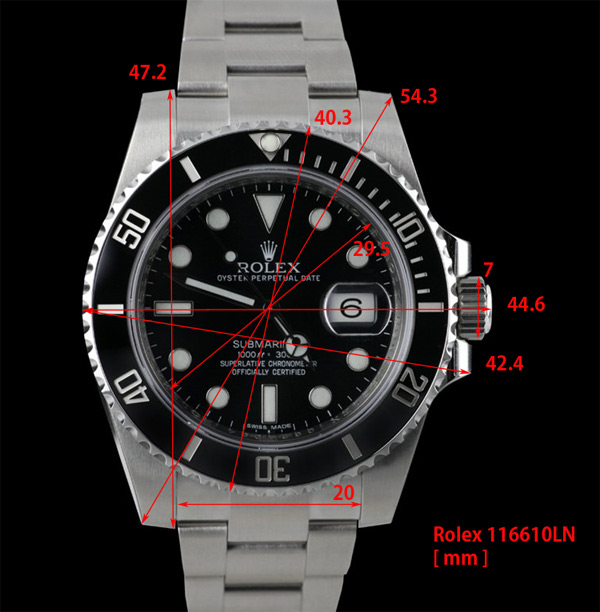
On May 16, Sydney Rotary club is organizing a Gala Reception and Fundraiser at Government House, Sydney. The aim is to raise funds for the Health Fund Timor Leste.
On the night, amongst other items, three wrist watches owned by Dr Jose Ramos-Horta will be put up for auction.
The Ex-President and Nobel Prize winner's watches are not something that appear on the open market every day, so this is a very unique opportunity to not only acquire a valuable timepiece but to be a part of benevolent action.
The watches are: a Patek Philippe 5196G, Corum 973.251.20 and IWC Portugueser signed "E&FF TO NOBEL PEACE PRIZE J RAMOS HORTA" . The Patek and Corum are brand new watches and the IWC has actually been worn by Dr Ramos-Horta and recently completely overhauled by IWC.
Should you wish to attend and bid, please contact Tony Benner on 0407 366 140. Or book online at www.trybooking.com/CNQT
The cost is $200 per person, of which $150 is tax deductible donation. RSVP by May 10.
Now, this invitation was a personal one, but in my wisdom I quickly promised to the Rotary club that I will share it with you too. Which still does not give you the right to bid against me on the 16th!
Of course, I won't disclose which watch is on top of my list, that would be too much of a help ;-)
However if you would like to see a set of photos then do email me. I have also suggested to the auctioneer that it would be a good idea to accept bids in writing, submitted prior to auction which would attract interstate bidders. What do you think? Interested?
See you at auction!
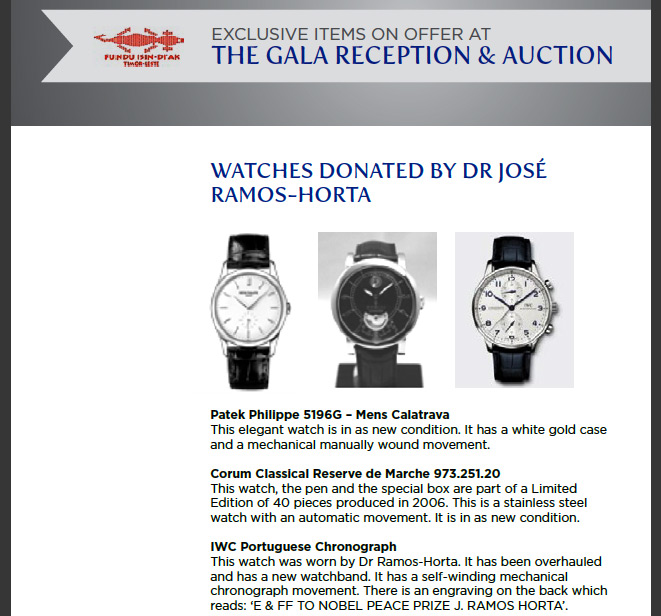
Guilloché (or Guilloche) is a decorative engraving technique in which a very precise intricate repetitive pattern or design is mechanically engraved into an underlying material with fine detail. The word is French for a pattern making tool like a geometrical lathe.
The most commonly seen guilloche is the one on bank notes. Watch dials, cases and internal components like bridges and wheels are sometimes engraved in such patterns, which is always a mark of quality.

Here is a nice example of guilloche dial:

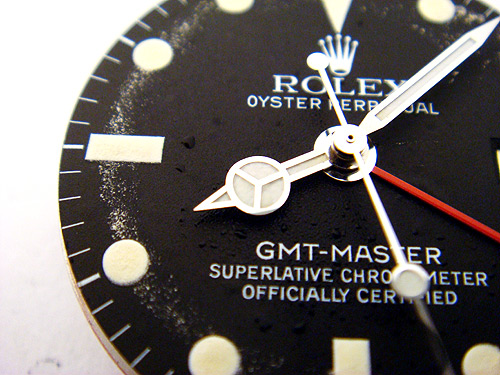
Arrived at our workshop at 4pm today, still full of water. Last serviced in 1998.
Obviously with no time to spare, all other jobs were pushed aside.
Once the movement was out of the case, the full extent of the water related damage was revealed: luminous material was partially diluted and spread all over the matte dial. And exposed to normal room temperature, it quickly dried, attaching itself to the dial surface.
The only way to clean the debris was to dampen the dial once again and then carefully remove excess luminous material, while trying to preserve the hour markers, writing and minute track intact.
The entire operation took about 30 minutes and the dial was then washed once again and left to dry at room temperature.
Beyeler, Singer, Stern, Lemrich and Metelem are just some of the Swiss dial makers who produced dials for various Rolex models.
This particular dial is a nice example of a fully signed Beyeler tritium dial. The GMT hand is a later replacement, but the watch features its original riveted bracelet.
The watch was bought in early 1970 for $400 and still belongs to it's original owner.
Overall result? We'll - you be the judge.
Another vintage 1675 dial preserved for the future :)
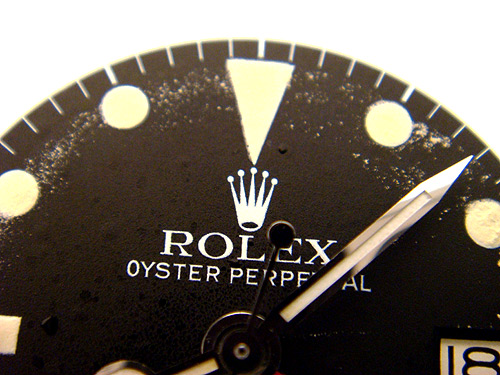
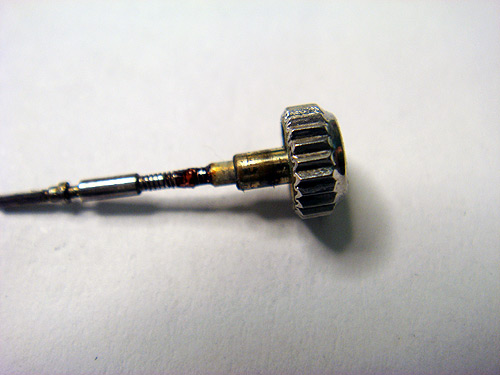
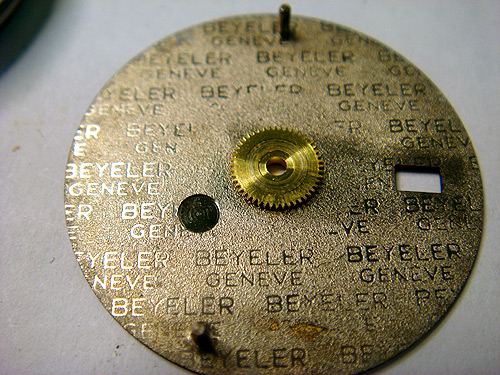
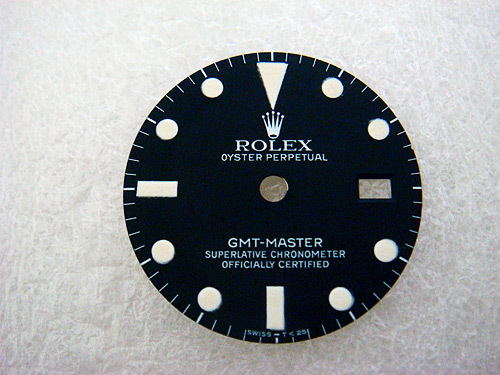
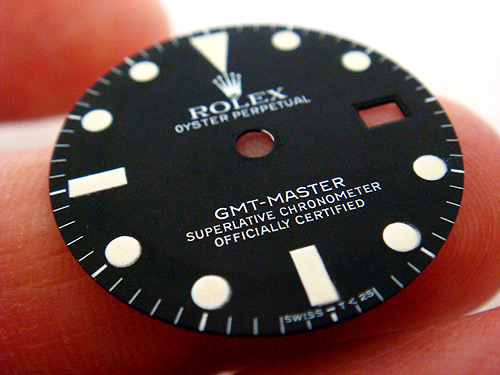
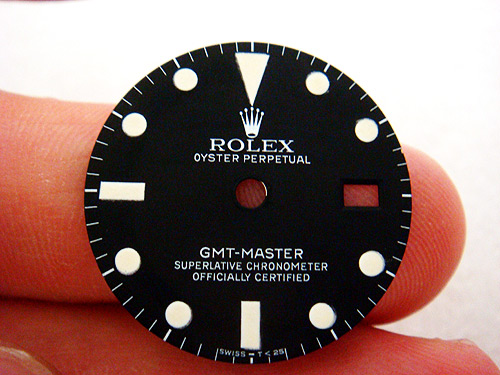
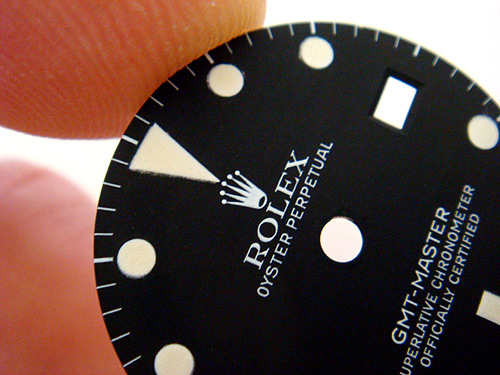
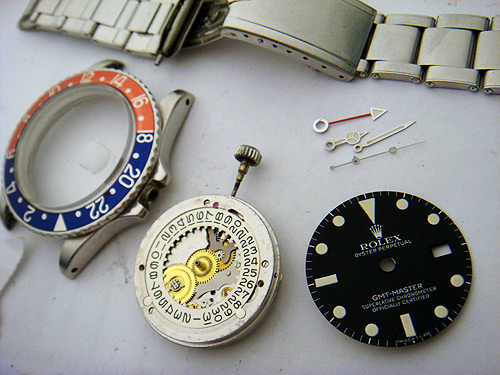
We are sending our Davosa Panamericana on an Australian Tour. And here is the exciting bit – we want you to be a part of its journey.
A brand new watch, never worn, checked for timekeeping and adjusted to 0 seconds per day, will embark on a one year journey around Australia. This is not only a horological trip but a social one. We want our Davosa to see as many places as possible in Australia. Take it to your work, on your fishing trip, to a wedding, anything you can think of. Surprise us! Shock us!
Of course, we know that you will take good care of it but we don’t expect this watch to arrive back in mint condition – we want it to be worn! We want you to wear it, to wind it and to hear it tick! If you want to, you can even play golf with it. The only thing we expect from you is an iconic Australian PHOTO that will capture our watch in a moment of your life that week, in a unique Australian setting!
This is going to be a watch with a big story and you will write the chapters!
What you have to do:
Receive the watch.
Wear the watch for a week.
Take photos of the watch.
Record a few notes in the logbook.
Send the watch onto an address we will provide.
This offer is an open invitation to all newsletters subscribers. TO REGISTER: Send us an email and let us know whether you are one of our existing customers or a newcomer.
Once on it's way, we intend to track the journey on Facebook- so stay tuned!
The watch:
Davosa Panamericana II Ref. 160.410.16. Case diameter: 42mm. Stainless steel case fitted on original Davosa brown leather with buckle. Sapphire crystal glass and exhibition case back. White dial with small seconds sub-dial and Arabic numeral hour markers. Manual wind.
Shipping:
The watch will be shipped to you in an Australia Post Mailing Box BX6 (Video / DVD box) Most likely, this cardboard box will only survive 2 or 3 trips so you may be required to buy a new box. This box is available at any Aust Post office. NOTE: preserve the foam protection which was cut to fit the watch and the BX3 box!
Postage: you will be required to cover postage to the next destination. Please send the watch as registered mail and keep the tracking number. Alternatively, you can send the watch in an Express Post satchel.
Ready to go !
Sydney 2000 NSW May 10, 2013. 10:12am.
Next Destination ???


Have fun!
Davosa Panaustraliana: on the road with Hon. Anthony Roberts MP !
"Gilgandra in Central NSW was the starting point for the Coo-ee March, where 26 men set out on foot on 10 October 1915 for Sydney, with the aim of recruiting volunteers for the war effort from the ...towns they passed along the way. By the time they reached Sydney on 12 November, some 263 men had joined their ranks and set sail for the battlefields of the First World War. This week NSW Fair Trading is in Gilgandra meeting with consumers and businesses to educate them on their rights and responsibilities in the marketplace. The starting point for the 1915 Coo-ee March seems like an appropriate place to kick off the Davosa Panaustraliana Tour!"
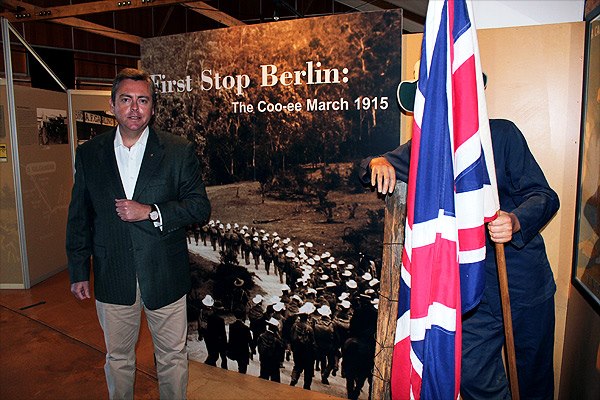

Human exploration and curiosity knows no limits. We've conquered almost every corner of the planet, been to the moon, and sent our tools and toys to Mars and way beyond! In essence, the quest for the unexplored is what makes us humans. Of course, there will always be a few who happily live by the famous Homer Simpson's maxima: "If something is too difficult, then it's not worth doing!"
What if...?
Would it be possible to send a wrist watch on a journey to visit every corner of the earth? And if it is possible, how long would such a journey take? What are the chances that it would return home safely, still keeping correct time? How can we solve obvious logistic problems? Most importantly, would it be fun to be a part of the story of The-most-travelled-watch-in-the world? In my books, the answer to all of the above is YES!
Read more at:
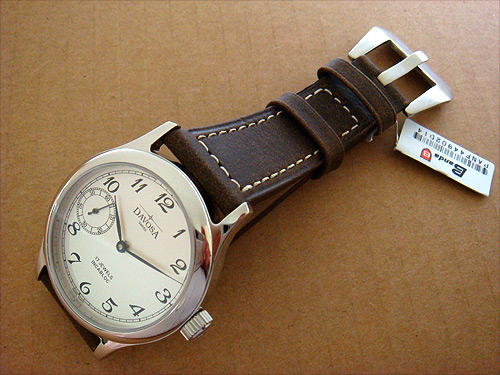
There is nothing that will make you look more stylish and give you a confidence boost like a nice pair of shoes. What you have on your feet can make or break any look.
A leather watch strap is like a pair of quality leather shoes. It doesn’t matter if you have the most amazing wrist watch in the world - if the leather strap is worn, discolored or dirty, you will be much better off leaving it at home.
With a wrong or worn leather strap, you won't impress anyone.
It is also fair to note that quality leather straps are hard to find, especially in Australia. While the Internet makes the search easy, choosing the right strap could be a challenge. On the other hand, if you do your research thoroughly, finding a perfect match between a strap and the watch is a very rewarding exercise.
Not to mention the obvious: an 'aftermarket' strap is significantly cheaper than the 'original' strap and you will have more flexibility of style, colour, size and length than you can think of!
A couple of weeks ago, I contacted a bunch of strap makers with an offer to supply a strap for 'the most travelled watch in the world'' tour. The idea was simple: show us what you can do for our watch and we'll tell the world about your strap-making skills.
In no time, we got 3 strap makers excited about our project.
The first one to take up the challenge was Mr. Frankie Tso from Banda. Frankie has been in the strap business for at least 30 years. Actually, when we first started our business in Sydney, we stocked Banda straps for a few years. We lost contact when the Australian wholesaler sadly passed away, but we cherished good memories of a quality product.
While I was familiar with the Banda straps, I did not know much about the history of the brand. A quick visit to the company website revealed that Frankie is very proud of his business:
BANDA, with over three decades of watch strap manufacturing experience, has earned a high reputation internationally as a high-grade leather watch strap maker. Established in 1978, the company dedicated itself as the main partner of a strap company in Switzerland. With traditional Swiss leather crafting expertise assisted by revolutionary Swiss machinery, BANDA is committed to being a prime player in the production of leather watch straps that have been appreciated by many prestigious global watch makers and watch strap aficionados ever since.
I shot an email to Frankie asking him to introduce Banda to our subscribers:
Frankie - it is obvious that love got you into the strap making business: the love for leather and the love for watches. While a high degree of technical knowledge, skill and patience, are require to craft an "art form", what is the most difficult process or phase in strap making? What is your ultimate challenge?
The process of developing a custom strap is very time consuming and requires a lot of patience from the leather craftsman due to the many small operations required for each strap. In general, the most important process is to cut the leather strap from the leather/skin so it is the exact size, length and shape specified by the client before other operations such as gluing, polishing/painting of the edges, stitching, adding strap keepers, hole punching etc. can be done.
The internet certainly makes the ordering process easier than ever?
Banda.com, one of the World's first websites for tailor made watchstraps, was first launched in 1996 just after internet access was made available for the general public. Over these years, Banda.com has been offering watch strap lovers a way to get custom bands built the way they want it. The current renovated site has also been built with an especially creative and straightforward system for watch lovers to create their very own straps.
What is the turnaround time for cutom-made straps?
Turnaround time for a custom watch strap is usually between 14 to 18 days. It is always worthwhile to wait as you will be more than happy ending up with an unique product created with your very own idea.
What is the most expensive watch you've made a strap for?
I have never asked my customers how expensive their watches are but I know I have made straps for many famous brands such as Patek Philippe, Audemars Piguet, Vacheron Constantin, Panerai etc.
Your most expensive strap?
Perhaps a XXXL custom strap in hornback alligator leather which was made to fit on an Audemars Piguet!
If you are to pick one strap in your entire production, which one would that be?It is hard to say as every strap is made to fit or match with particular watch models. Therefore, I believe there is no one perfect strap, but rather a perfect strap for every user for every watch. Watch collectors all over the world are fashion-conscious men and women who are very particular about their watches - not just about the timepiece itself but also the watch strap material, color, design, pattern and stitching with every client having his or her own preferences.
This morning, a small parcel arrived on my bench containing six Banda straps custom made for the world travelling watch. Obviously, Frankie is someone you can trust: a reliable and prompt businessman.
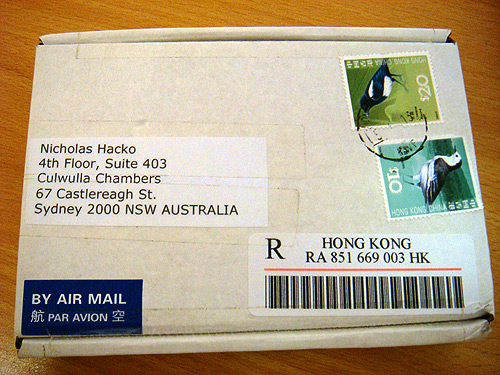
I felt like a seven year old girl who just got a new set of fancy dresses for her Barbie doll :-)
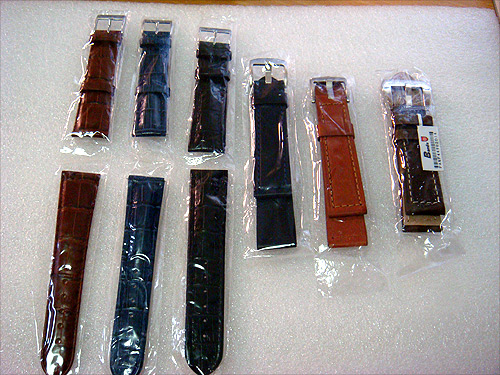
The very first strap to fit on the Davosa was the BANDA VINTAGE JACKET. This dark brown vintage looking strap gave the Davosa a cool and casual appearance:
The highly polished buckle was a perfect match to the watch case.
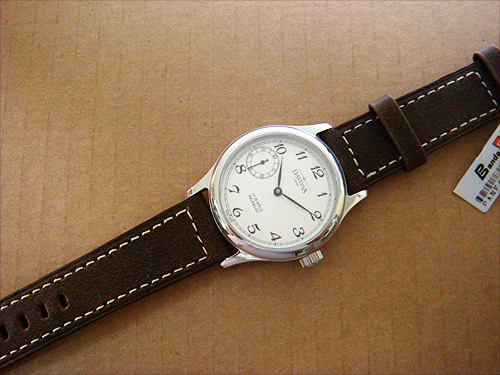
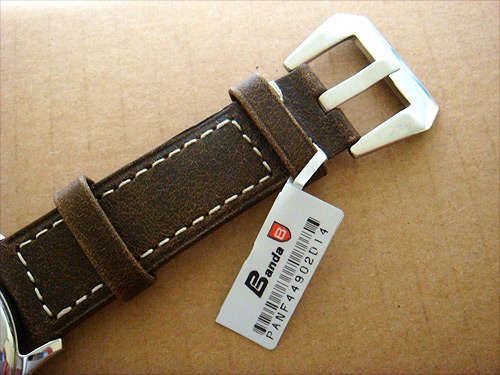
BANDA does not need my endorsement or promotion to continue doing what they do the best. Rest assured: in the next few weeks to come, you will see more of Frankies creations not only on the Davosa but on some of our other watches as well!
Whether you intend to spend money with Frankie or not, is entirely up to you. However, it is important to keep in mind that hard working craftsman who are there to support your hobby are not easy to find.
I for one am grateful to Frankie and his team for providing some very fine straps to both watch enthusiasts and watch professionals.
BANDA's website is www.banda.com or if you prefer even more personal contact, mention my name and email Frankie at info@banda.com.

While I am not a big movie goer, I could not resist watching Baz Luhrmann's The Great Gatsby. The movie critics - especially the NY bunch- were a bit unkind to Luhrmann's latest movie accusing him of "(over)size, overstatement and noise" and of the film being "shallow but operatic".
Personally, I just could not have enough of it!
The cast was fantastic, not to mention the decore, the music and the truly interpreted dynamics of Fitzgerald's novel. But above all: the colours! The best of Bollywood meets the roaring 1920s. Quite frankly I would have loved it even more if it was even more grand, louder and theatrical.
In particular, the scene where Gatsby breaks the clock and then makes a clumsy attempt to fix it reminded me of an event from around 2007.
On the other end of the line was a polite voice of a young gentleman:
"Do you repair clocks? I have been asked by my boss to contact you. His clock needs some attention."
The clock arrived in the mail a few days later. It was a rather inexpensive plastic-cased alarm clock. Something you would find in Vinnies, on the bottom shelf, underneath the pile of "How to" books and prints of the Opera House.
I rang back the number and explained to the young man that the clock is simply not worth repairing.
I explained why, in detail. He listened to me patiently and said:
"I appreciate your assessment. Indeed the clock is not worth much, but it does have a huge sentimental value to my employer."
"It will take me 2 days to repair it, which translates to a $500 repair bill, with no guarantee on performance". I was trying very hard not to get the job.
"Please go ahead, and thank you in advance. Do your best, it will be appreciated".
I have to say that overly polite customers were hard to find back then as much as they are hard to find today. So I got into it. To its credit, after a complete re-build, the poor clock kept fairly decent time, and the alarm bell was spot on.
The check arrived in the mail, and the clock was returned the same way.
A few weeks later I got the last piece of correspondence which closed the case. This time, it came directly from the owner. "Thank you for repairing my clock. Yours, Baz Luhrmann".
Where the boy from a small rural town in New South Wales, raised by a farmer and petrol station owner father and dress shop owner mother got his vision, imagination and inspiration, will - at least for me - remain a mystery.
Of one, I am convinced: only great people with attention to the smallest detail can make the greatest movies.
While most of your (and our) customers don't really care much about what you do, WE KNOW how you feel when you place the watch on a timing machine.
The moment of truth. Some things cannot be faked.

